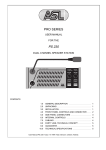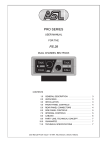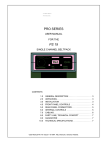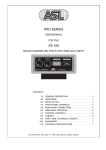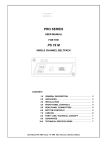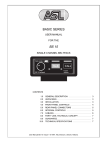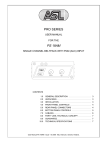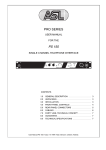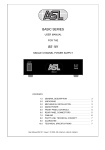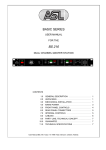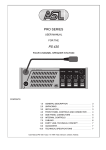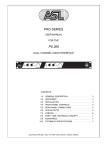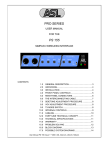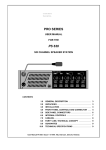Download ASL INTERCOM PS 130 User manual
Transcript
PRO SERIES
USER MANUAL
FOR THE
PS 130
SINGLE CHANNEL SPEAKER STATION
CONTENTS
1.0
2.0
3.0
4.0
5.0
6.0
7.0
8.0
9.0
10.0
GENERAL DESCRIPTION . . . . . . . . . . . . . . . . . . . . . .
UNPACKING . . . . . . . . . . . . . . . . . . . . . . . . . . . . . . . . .
INSTALLATION . . . . . . . . . . . . . . . . . . . . . . . . . . . . . . .
FRONT PANEL CONTROLS AND CONNECTOR . . . .
SIDE PANEL CONNECTORS . . . . . . . . . . . . . . . . . . . .
INTERNAL CONTROLS . . . . . . . . . . . . . . . . . . . . . . . .
CABLING . . . . . . . . . . . . . . . . . . . . . . . . . . . . . . . . . . . .
PARTY LINE, TECHNICAL CONCEPT . . . . . . . . . . . . .
GUARANTEE . . . . . . . . . . . . . . . . . . . . . . . . . . . . . . . . .
TECHNICAL SPECIFICATIONS . . . . . . . . . . . . . . . . . .
User Manual PS 130 / Issue 1 © 1994 ASL Intercom, Utrecht, Holland.
3
3
4
4
5
5
6
7
7
7
2
User Manual PS 130 / Issue 1 © 1994 ASL Intercom, Utrecht, Holland.
1.0
GENERAL DESCRIPTION
The PS 130 is a single channel speaker station designed
for use in both portable and fixed intercom systems.
It incorporates a loudspeaker and a gooseneck
microphone and provides full duplex communications
within an ASL intercom system. The PS 130 RM model
has a small built-in electret microphone.
At the front panel are a Volume (listen level) control, a Talk
and Call button with LED indicators and a two-stage
sidetone trimmer.
The unit is equiped with a limiter for the gooseneck
microphone, allowing the user to speak close into the
microphone without giving rise to overload and distortion.
Loudspeaker dimming is automatic when the microphone
is active. Private conversation may be carried out via the
headset connector with a headset or telephone handset.
When a headset is connected, both the gooseneck
microphone and speaker are disabled automatically.
2.0
The unique ASL CALL system provides both a flashing red
LED and a very distinctive and characteristic sound signal.
Smooth operation is guaranteed with the CALL button.
Only a slight touch makes the red LED flash, whilst holding
the button for two seconds will activate the CALL sound
signal. The volume of the sound signal (buzzer) can be
adjusted at the front panel.
Fully electronic switching increases reliability and allows
for :
- 'soft' microphone ON switching, latched or momentary
- remote Mic Mute facility.
- automatic speaker attenuation (adjustable), when the
microphone is activated.
UNPACKING
The shipping carton contains the parts below:
*
*
The PS 130
User manual
If any are missing, contact your dealer.
ASL has taken great care to ensure this product reaches
you in flawless condition.
3.0
Special attention has been paid to the intelligibility of
speech. By applying low noise/high speed opamps, a
speech presence filter and a specially developed high
power bridged headphone amplifier, communication is
very comfortable even in environments with high background-noise level. There is a separate amplifier for the
loudspeaker.
After unpacking the unit please inspect for any physical
damage to the unit, and retain the shipping carton and
relevant packing materials for use should the unit need
returning.
If any damage has occured, please notify your dealer
immediately so that a written claim can be initiated. Please
also refer to the guarantee section of this manual.
INSTALLATION
This PS 130 will form part of an existing or new intercom
system, and connection to it is straightforward. There are
no separate power connections or batteries to install, as
the necessary DC voltages are derived from a master
station or a separate power supply, via the intercom
connection cable.
The PS 130 is fully protected against mis wiring (reverse
power) or short circuit in the interconnect cables.
A special kit is available for mounting the PS 130 in a 19"
rack, taking 2U of rackspace.
To connect the PS 130 to the intercom system, use
professional flexible microphone cable with 2 wires and 1
shield only. Connect the system intercom cable to the
LINE connector on the side panel. Finally, when private
conversation is desired, connect the listening headset plug
into the HEADSET connector on the front panel.
User Manual PS 130 / Issue 1 © 1994 ASL Intercom, Utrecht, Holland.
3
4.0
FRONT PANEL CONTROLS AND CONNECTOR
1
VOLUME control knob
This knob adjusts the listen level for the headset and
the loudspeaker.
2
TALK button
This push button activates the gooseneck or headset
microphone, the large green LED indicates if the
microphone is switched on.
6
It prevents :
- unit feedback if sidetone rejection is not sufficient.
- system feedback or a 'hollow' sound when the
microphone's of other speaker stations on the
same channel are activated simultaneously.
Latched switching:
When a TALK button is pressed quickly, the
microphone will be switched on, and is electronically
latched. When pressed again, the microphone will be
switched off.
Adjustment procedure :
- switch off TALK buttons.
- inject an audio signal on the intercom channel.
- turn up volume.
- activate microphone and adjust the desired amount
of attenuation.
When the microphone is latched on, it can be muted by
a Mic Mute from a PRO Series master station or
separate power supply.
Momentary switching:
When a TALK button is pressed and held, the
microphone will be switched on, and when released,
will be switched off.
3
CALL button
This push button activates the call system.
A momentary push will send a call signal to all stations
connected to the intercom channel and the call LEDS
will start flashing.
Press and hold the button for 2 seconds will activate
the call buzzer, if not muted.
After the CALL button is released the LEDS will
continue to flash for further 2 seconds.
4
SIDETONE LEVEL trimmer
This trimmer controls the level of your own voice as
you hear it in the speaker or in the headset.
It prevents the speaker from feeding back into the
microphone.
5
SIDETONE HI trimmer
This trimmer controls the rejection in the high
frequency range. It compensates the capacity of the
interconnecting cables and prevents the speaker from
feeding back into the microphone (unit feedback).
Adjustment procedure for both sidetone trimmers :
- set trimmer in start position : fully clockwise.
- switch off the microphone of all connected (speaker
!) stations.
- switch on the microphone of the PS 130.
- turn up volume.
- speak into the headset microphone.
- adjust the listen level by turning the sidetone
trimmer.
The operating area is between fully clockwise and
minimum level. Adjusting the sidetone does not affect
the level of your voice as it is heard by other stations.
4
SPEAKER ATTENUATOR trimmer
This trimmer allows you to dim the speaker automatically, when the gooseneck microphone is switched on.
The speaker attenuator has no effect when a headset
is used.
7
BUZZER VOLUME trimmer
This trimmer adjusts the volume of the internal buzzer,
which is located behind the front panel.
The buzzer is activated if you press the CALL button of
the PS 130 or a CALL button of any other station (on
the channel to which the PS 130 is connected), longer
than 2 seconds and the buzzers are not muted (on the
master station or power supply).
8
GOOSENECK MICROPHONE
A high quality electret noise canceling microphone.
A limiter prevents the microphone preamplifier from
clipping when speaking close into the microphone.
9
HEADSET connector
An XLR-4 type connector for the connection of a local
headset when private conversation is desired. This
headset must have a can impedance of 200 ohms (or
greater), or each 400 ohms minimum when in parallel.
The microphone may be of the dynamic or electret
type.
Pin assignments :
1. Shield mic. (GND)
2. mic. +
3. phones +
4. phones When connecting a headset, the speaker and
gooseneck microphone will be disabled automatically.
10 LOUDSPEAKER
A high quality loudspeaker driven by a 1.3 Watt
amplifier.
Speaker and gooseneck microphone automatically
shut off when a headset is used.
User Manual PS 130 / Issue 1 © 1994 ASL Intercom, Utrecht, Holland.
4.0
FRONT PANEL CONTROLS AND CONNECTOR
5.0
SIDE PANEL CONNECTORS
11 LINE connectors
These XLR-3 connectors are for connecting the PS
130 to the intercom system.
Pin assignments :
1. 0 V / ground shield
2. +30 V power wire
3. audio wire
The female connector is for input.
The male connector is for extending the intercom line
to other stations.
6.0
INTERNAL CONTROLS
Inside the unit there are two trimmers to adjust the mic
gain of the gooseneck microphone and the headset
microphone separately. These internal controls are located
on a P.C.board.
They can be reached as follows :
- remove the screws of the bottom plate.
- slide the plate to one side and take it out.
- take away the plastic isolation plate.
User Manual PS 130 / Issue 1 © 1994 ASL Intercom, Utrecht, Holland.
The two trimmers are labeled :
GOOSE for the gooseneck microphone
HEADS for the headset microphone.
5
7.0
CABLING
For the PRO Series Intercom system the interconnecting
cables are of the shielded two-conductor microphone
cable type and the intercom line connectors are of the
XLR-3 type. Audio and Call signals are on XLR pin 3, DC
power is on XLR pin 2. XLR pin 1 is connected to the
shield of the cable which functions as the common return
for audio and power.
¼
Since the audio signal is transferred in an unbalanced
way, certain rules have to be obeyed when installing the
cables of an intercom network. This is to avoid earth loops
and to minimize power loss and the possible effect of
electromagnetic fields.
These rules are:
Use high quality (multipair) cable.
For interconnecting user stations, power supplies and
accessories in an ASL Intercom network, use high
quality shielded two-conductor (minimum 2x 0.30 mm2)
microphone cable only.
In case of a multi channel intercom network, use high
quality microphone 'multipair' cable only, each pair
consisting of two conductors (minimum 2x 0.15 mm2)
with separate shield. Multipair cable should have an
overall shield as well.
Use flexible cables.
Use flexible single and multipair microphone cable
instead of cable with solid cores, especially when the
cable is subjected to bending during operation or
installation.
Separate cable screen to XLR pin 1.
The screen of each separate microphone cable and/or
the screen of each single pair in a multipair cable,
should be connected to pin 1 of each XLR-3 connector.
Do not connect this cable screen to the metal housing
of the connector or to metal wall boxes (outlets).
See page 10 for Earthing Concept.
Cable trunks, connection boxes and overall
multipair cable screen to clean earth.
Metal cable trunks, metal connection boxes and overall
multipair cable screen should be interconnected and,
at one point (the 'central earthing point') in the intercom
network only, be connected to a clean earth or a safety
earth.
See page 10 for Earthing Concept.
Keep metal connection boxes and cable trunks
isolated from other metal parts.
Metal housings for intercom cables and connectors
should be mounted in such a way that they are isolated
from other metal cable and connector housings and
from any other metal construction parts.
Keep cables parallel as much as possible.
When two (multi channel) units in a network are
connected by more than one cable, make sure that
these cables are parallel to each other over the whole
distance between those units. When using multipair
cable, parallelism is ensured in the best possible way.
Avoid closed loops.
Always avoid that cables are making a loop. So-called
'ring intercom' should not physically be cabled as a
ring. All cable routes should have a 'star' configuration,
with the central earthing point (usually close to the
power supply position) as the centre of the star.
Keep cables away from electromagnetic sources.
Keep intercom cables away from high energy cables,
e.g. 110/220/380V mains power or dimmer controlled
feeds for spotlights.
Intercom cables should cross high energy cables at an
angle of 90( only.
Intercom cables should never be in the same trunking
as energy cables.
Place power supply in a central position.
In order to avoid unacceptable power losses, place the
power supply as close as possible to where most
power consumption occurs or, in other words, most
user stations are placed.
Connect ASL power supply to a 'clean' mains
outlet.
The ASL power supply may be connected to the mains
power outlet to which other audio equipment is
connected. Avoid using mains outlets which also power
dimmer controlled lighting systems.
In case of more complex installations, don't hesitate to
contact us. Please send us a block diagram of the planned
network with a list of all user stations and their positions,
and we are happy to advise you on cabling lay out.
¼ See Party Line, Technical Concept.
6
User Manual PS 130 / Issue 1 © 1994 ASL Intercom, Utrecht, Holland.
8.0
PARTY LINE, TECHNICAL CONCEPT
ASL's PRO Series offers a complete two way ('full duplex')
communications system.
Users of the system are connected via a 'party line'.
Master stations (with built-in power supply), beltpacks,
speaker stations and power supplies are interconnected
via standard microphone cable. One wire is used as an
audio line, one as a power line and the screen of the cable
functions as earth/return.
Current drive is used for signal transfer. Each station
utilises a current amplifier to amplify the microphone signal
and place it on the common audio line where, due to the
constant line impedance (situated in the power supply
between XLR pin 3 and 1), a signal voltage is developed
which can be further amplified and sent to headphones or
loudspeakers.
This principle has three advantages:
- the use of a single audio line allows several stations to
talk and listen simultaneously.
- due to the high bridging impedance offered by each
station, the number of stations 'on line' has no
influence on the level of the communications signal.
- power and audio to the intercom stations use the same
cable.
The Call signal is also sent as a current on the audio line.
It develops a DC potential over the line impedance which
will be sensed by each station and interpreted as a Call
signal.
9.0
GUARANTEE
This unit is warranted by ASL Intercom to the original enduser purchaser against defects in workmanship and
materials in it's manufacture for a period of one year from
date of shipment to the end-user.
Faults arising from misuse, unauthorised modifications or
accidents are not covered by this warranty. If the unit is
faulty it should be sent in it's original packing, to the
supplier or your local ASL dealer, with shipping prepaid. A
note must be included stating the faults found and a copy
of the original suppliers invoice.
10.0 TECHNICAL SPECIFICATIONS PS 130
POWER CONSUMPTION
current (at 30 V DC)
35 mA quiescent
70 mA signalling
190 mA at max. output + signalling
MIC. PREAMP
gooseneck microphone type
noise cancelling electret
headset mic. impedance
200 ohms
gain
40 dB - 70 dB (adjustable internally)
presence filter
+6 dB at 5 kHz
frequency response
200 Hz - 13 kHz (-3 dB)
V electret mic
+9 V DC
HEADPHONES DRIVER AMP
max. load
max. output level
max. output power
200 ohms
14 V rms (200 ohms)
0.5 W rms (each can)
SPEAKER DRIVER AMP
speaker impedance
max. output power
INTERCOM LINE DRIVER
max. output current
output impedance
SIDETONE
rejection
BUZZER
max. SPL
DIMENSIONS AND WEIGHT
width
height
depth
weight
50 ohms
1.3 W rms
3 mA rms
> 150 Kohms
0 - 30dB adjustable
100 dBA
230 mm
88 mm
42/48 mm sloping
1.1 Kg
GENERAL SYSTEM SPECIFICATIONS
intercom line impedance
350 ohms (1kHz)
2.2 Kohms (DC)
intercom line audio level
nom. -18 dBu
max. +4 dBu
dynamic range
80 dB
call send signal
+2.8 mA
call receive signal threshold
+2.4 V DC
supply voltage
+30 V DC (12 V to 32 V)
mic mute power interrupt time
0.1 sec
Note: 0 dBu = 775 mV into open circuit
THIS PRODUCT WAS DESIGNED, DEVELOPED AND
MANUFACTURED BY:
ASL reserves the right to alter specifications without further
notice.
AMPCO SOUND LAB BV
MAARSSEN (UTRECHT) HOLLAND.
User Manual PS 130 / Issue 1 © 1994 ASL Intercom, Utrecht, Holland.
7
8
User Manual PS 130 / Issue 1 © 1994 ASL Intercom, Utrecht, Holland.
User Manual PS 130 / Issue 1 © 1994 ASL Intercom, Utrecht, Holland.
9
10
User Manual PS 130 / Issue 1 © 1994 ASL Intercom, Utrecht, Holland.
User Manual PS 130 / Issue 1 © 1994 ASL Intercom, Utrecht, Holland.
11











